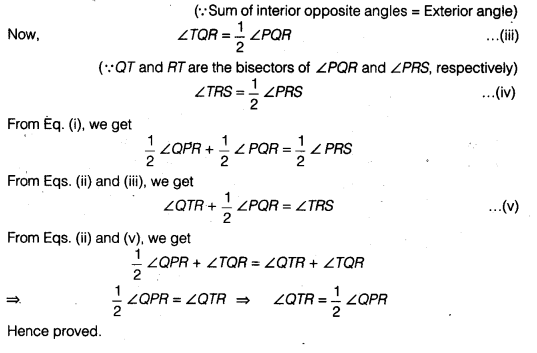GetStudySolution
Getstudysolution is an online educational platform that allows students to access quality educational services and study materials at no cost.
NCERT Solutions for class 9 Maths chapter 6 – Lines and Angles
Back Exercise
Exercise 6.1
Question 1.
In figure, lines AB and CD intersect at 0. If ∠AOC + ∠BOE = 70° and ∠BOD = 40°, find ∠BOE and reflex ∠COE.
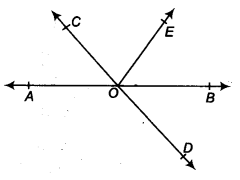
Solution:
Here, ∠AOC and ∠BOD are vertically opposite angles.
∴ ∠AOC = ∠BOD
⇒ ∠AOC = 40° [∵ ∠BOD = 40°(Given)] …(i)
We have, ∠AOC + ∠ BOE = 70° (Given)
40°+ ∠BOE = 70° [From Eq. (i)]
⇒ ∠BOE = 30°
Also, ∠AOC + ∠COE + ∠BOE = 180° (Linear pair axiom)
⇒ 40° + ∠COE + 30° = 180°
⇒ ∠COE = 110°
Now, ∠COE + reflex ∠COE = 360° (Angles at a point)
110°+reflex ∠COE = 360°
⇒ Reflex ∠COE = 250°
Question 2.
In figure, lines XY and MN intersect at 0. If ∠POY = 90° , and a : b = 2 : 3. find c.
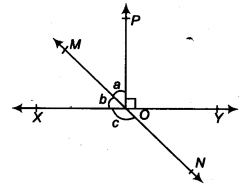
Solution:
We have, ∠POY = 90°
⇒ ∠POY + ∠POX = 180° (Linear pair axiom)
⇒ ∠POX = 90°
⇒ a+b = 90°
Also, a : b = 2 : 3 (Given)
⇒ Let a = 2k,b = 3k
Now, from Eq. (j), we get
2k + 3k = 90°
⇒ 5k = 90°
⇒ k = 18°
∴ a = 2 x 18°=36°
and b=3 x 18°=54°
Now, ∠MOX + ∠XON = 1800 (Linear pair axiom)
b+ c = 180°
⇒ 540 + c= 180°
⇒ c = 126°
Question 3.
In figure, ∠PQR = ∠PRQ, then prove that ∠PQS = ∠PRT.
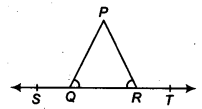
Solution:
∵ ∠PQS+ ∠PQR = 180° (Linear pair axiom) ,..(i)
and ∠PRT + ∠PRQ = 180° (Linear pair axiom).. .(ii)
From Eqs. (i) and (ii), we get
∠PQS + ∠PQR =∠PRT + ∠PRQ
∠PQS + ∠PRQ =∠PRT + ∠PRQ
[Given, ∠PQR = ∠PRQ]
⇒ ∠PQS = ∠PRT
Question 4.
In figure, if x + y = w + z, then prove that AOB is a line.
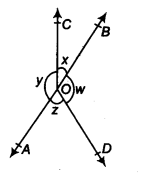
Solution:
∵ x+ y+w+ z = 360° (Angle at a point)
x + y = w + z (Given)…(i)
∴ x+ y+ x+ y = 360° [From Eq. (i)]
2(x + y) = 360°
⇒ x + y = 180° (Linear pair axiom)
Hence, AOB is a straight line.
Question 5.
In figure, POQ is a line. Ray OR is perpendicular to line PQ. OS is another ray lying between rays OP and OR. Prove that
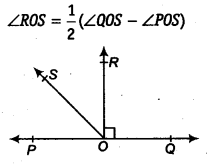
Solution:
We have,
∠POR = ∠ROQ = 90° (∵ Given that, OR is perpendicular to PQ)
∴ ∠POS + ∠ROS = 90°
⇒ ∠ROS = 90° – ∠POS
On adding ∠ROS both sides, we get
2 ∠ROS = 90° – ∠POS + ∠ROS
⇒ 2 ∠ROS = (90° + ∠ROS) – ∠POS
⇒ 2∠ROS = ∠QOS – ∠POS (∵ ∠QOS = ∠ROQ + ∠ROS = 90° + ∠ROS)
⇒ ∠ROS =
Hence proved.
Question 6.
It is given that ∠XYZ = 64° and XY is produced to point P. Draw a figure from the given information. If ray YQ bisects ∠ZYP, find ∠XYQ and reflex ∠QYP.
Solution:
Here, YQ bisects ∠ZYP.
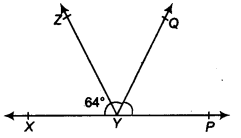
Hence, ∠ZYQ = ∠QYP =
Given, ∠XYZ = 64° ….(ii)
∵ ∠XYZ + ∠ZYQ + ZQYP = 180° (Linear pair axiom)
⇒ 64° + ∠ZYQ + ∠ZYQ = 180° [From Eqs. (i) and (ii)]
⇒ 2 ∠ZYQ = 180° – 64°
⇒ ∠ZYQ =
⇒ ∠ZYQ = 58°
∴ ∠XYQ = ∠XYZ + ∠ZYQ = 64° + 58° = 122°
Now, ∠QYP + reflex ∠QYP = 360°
58° + reflex ∠QYP = 360°
⇒ reflex ∠ QYP = 302°
Exercise 6.2
Question 1.
In figure, find the values of x and y and then show that AB || CD.
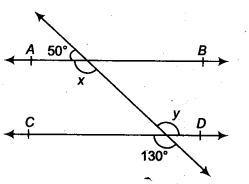
Solution:
∵ x + 50° = 180° (Linear pair)
⇒ x = 130°
∴ y = 130° (Vertically opposite angle)
Here, ∠x = ∠COD = 130°
These are corresponding angles for lines AB and CD.
Hence, AB || CD
Question 2.
In figure, if AB || CD, CD || EF and y: z = 3:7, find x.
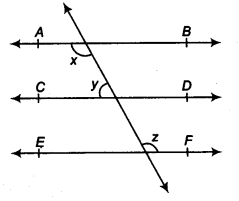
Solution:
Given
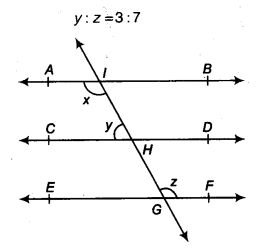
⇒ Let y = 3k, z = 7k
x = ∠CHG (Corresponding angles)…(i)
∠CHG = z (Alternate angles)…(ii)
From Eqs. (i) and (ii), we get
x = z …….(iii)
Now, x+y = 180°
(Internal angles on the same side of the transversal)
⇒ z+y = 180° [From Eq. (iii)]
7k + 3k = 180°
⇒ 10k = 180°
⇒ k = 18
∴ y = 3 x 18° = 54°
and z = 7x 18°= 126°
∴ x = z
Now, x + y = 180°
(Internal angles on the same side of the transversal)
⇒ z + y = 180° [From Eq. (iii)]
7k + 3k = 180°
⇒ 10k = 180°
⇒ k = 18
∴ y = 3 x 18° = 54°
and z = 7x 18°= 126°
x = z
⇒ x = 126°
Question 3.
In figure, if AB || CD, EF ⊥ CD and ∠GED = 126°, find ∠AGE, ∠GEF and ∠FGE.
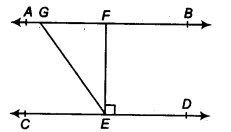
Solution:
∵ ∠AGE = ∠GED (Alternate interior angles)
But ∠GED = 126°
⇒ ∠AGE = 126° ….(i)
∴ ∠GEF + ∠FED= 126°
⇒ ∠GEF + 90° =126° (∵ EF ⊥ CD)
⇒ ∠GEF = 36°
Also, ∠AGE + ∠FGE = 180° (Linear pair axiom)
⇒ 126° + ∠FGE =180°
⇒ ∠FGE = 54°
Question 4.
In figure, if PQ || ST, ∠ PQR = 110° and ∠ RST = 130°, find ∠QRS.

Solution:
Drawing a tine parallel to ST through R.
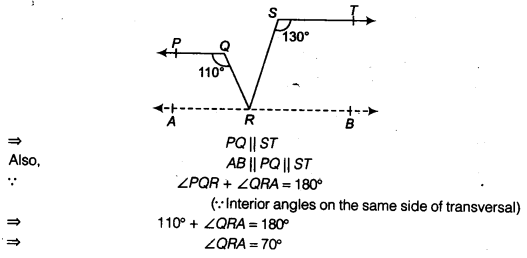

Question 5.
In figure, if AB || CD, ∠APQ = 50° and ∠PRD = 127°, find x and y.
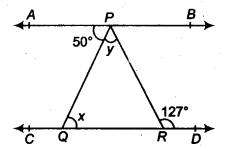
Solution:
We have, AB || CD
⇒ ∠APQ = ∠PQR (Alternate interior angles)
⇒ 50° = x
⇒ x = 50°
Now, ∠PQR + ∠QPR = 127°
(Exterior angle is equal to sum of interior opposite angles of a triangle)
⇒ 50°+ ∠QPR = 127°
⇒ y = 77°.
Question 6.
In figure, PQ and RS are two mirrors placed parallel to each other. An incident ray AB strikes the mirror PQ at B, the reflected ray moves along the path BC and strikes the mirror RS at C and again reflects back along CD. Prove that AB || CD.
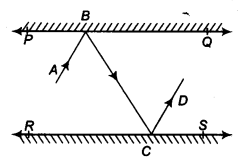
Solution:
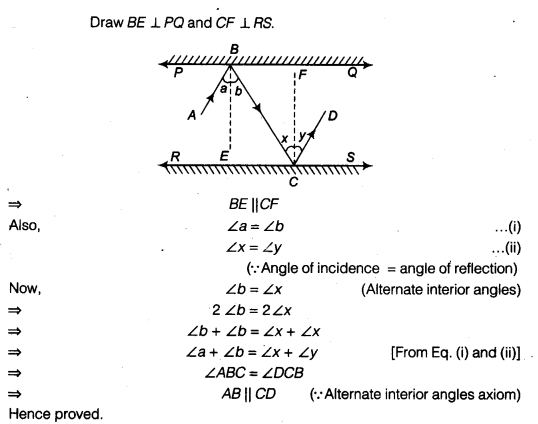
Exercise 6.3
Question 1.
In figure, sides QP and RQ of APQR are produced to points S and T, respectively. If ∠SPR = 135° and ∠PQT = 110°, find ∠PRQ.

Solution:


Question 2.
In figure, ∠X – 62°, ∠XYZ = 54°, if YO and ZO are the bisectors of ∠XYZ and ∠XZY respectively of ∆XYZ, find ∠OZY and ∠YOZ.
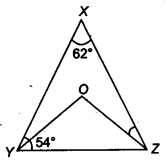
Solution:
In ∆XYZ,
∵ ∠X+ ∠Y+ ∠Z = 180°
(Sum of all angles of triangle is equal to
∴ 62° + ∠Y + ∠Z = 180° [YZX = 62° (Given)]
⇒ ∠Y + ∠Z = 118° .
⇒
⇒ ∠OYZ + ∠OZY = 59°
(∵ YO and ZO are the bisectors of ∠XYZ and ∠XZY)


Question 3.
In figure, if AB || DE, ∠BAC = 35° and ∠CDE = 539 , find ∠DCE.
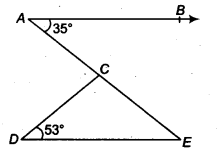
Solution:
We have AB || DE
⇒ ∠AED= ∠ BAE (Alternate interior angles)
Now, ∠ BAE = ∠ BAC
⇒ ∠ BAE = 35° [ ∵ ∠ BAC = 35° (Given) ]
∴ ∠ AED = 35°
In ∆DCE,
∵ ∠DCE + ∠CED+ ∠EDC= 180° ( ∵Sum of all angles of triangle is equal to 180°)
⇒ ∠ DCE + 35°+ 53° = 180° ( ∵∠ AED = ∠ CED = 35°)
⇒ ∠ DCE = 180° – (35° + 53°)
⇒ ∠ DCE = 92°
Question 4.
In figure, if lines PQ and RS intersect at point T, such that ∠ PRT = 40°, ∠ RPT = 95° and ∠TSQ = 75°, find ∠ SQT.

Solution:
∵∠PTS = ∠RPT + ∠PRT (Exterior angle = Sum of interior opposite angles)
∠ PTS = 95° + 40° [∵ ∠PPT = 95° (Given)]
⇒ ∠ PTS = 135° [and ∠PRT = 40°]
Also, ∠ TSQ + ∠ SQT = ∠ PTS (Exterior angle = Sum of interior opposite angles)
⇒ 75°+ ∠ SQT = 135°
⇒ ∠ SQT = 60° [∵ ∠ TSQ = 75° (Given)]
Question 5.
In figure, if PQ ⊥ PS, PQ||SR, ∠SQR = 2S° and ∠QRT = 65°, then find the values of x and y.
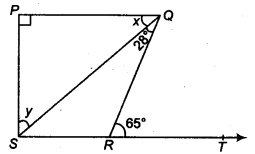
Solution:
Here, PQ || SR
⇒ ∠ PQR = ∠ OPT (Alternate interior angles)
⇒ x + 28° = 65° ⇒ x = 37°
Now, in right angled ASPQ, we have ∠P = 90°
∴ ∠P + x + y = 180° (∵ Sum of all angles of a triangle is equal to 180°)
⇒ 90°+ 37°+ y= 180°
⇒ 127°+ y=180°
⇒ y = 53°
Question 6.
In figure, the side QR of A PQR is produced to a point S. If the bisectors of ∠PQR and ∠PRS meet at point T, then prove that

Solution:
In ∆ PQP,
∵ ∠QPR + ∠PQR = ∠PRS …(i)
(∵ Sum of interior opposite angles = Exterior angle)
Now, in ∆ TOR,
∵ ∠QTR + ∠TQR = ∠TRS …..(ii)
